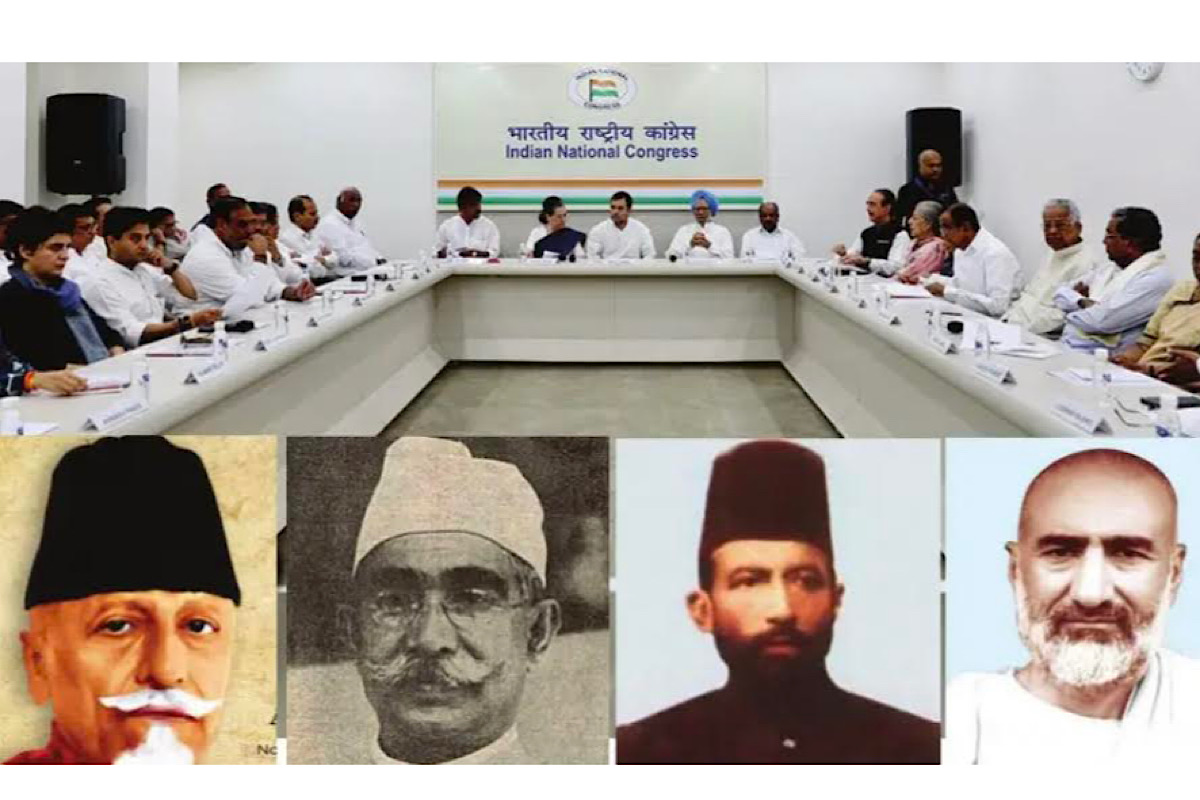The 85th Congress plenary session, held in Chhattisgarh from 24 to 26 February, has made news, often for the wrong reasons. It has provoked writers-commentators to find ‘missing’ icons in the pantheon of past party presidents showcased. Its focus on ‘137 Year Journey of Ideas’ seemed indicative of the Grand Old Party no longer driven by ideals of equality, justice, brotherhood, and the passion to build a nation. Maulana Abul Kalam Azad is the first ‘miss’ among the pantheon of Congress leaders. Azad was not only the party’s youngest president in 1923 (a hundred years ago), from 1940 to 1946 he remained at the helm, even though he was in jail along with other Congress leaders after the 1942 Quit India movement.
In Azad’s generation, Hakim Ajmal Khan and M A Ansari were equally prominent personalities who contributed significantly to the party when they assumed charge as Presidents. Rafi Ahmed Kidwai, though never a party president, was a venerated senior leader, fund-raiser, and a popular minister of the Congress in independent India.
If the Congress of today was looking to its history to unite the nation, it could have put the spotlight on these larger-than-life Muslim leaders, as if to affirm it was upholding meaningful and relevant political legacies which would otherwise be marginalized. Or simply forgotten in today’s fast globalizing times.
Frontier Gandhi, as Khan Abdul Ghaffar Khan was endearingly referred to, is another towering Pashtun leader who comes to mind whenever a debate on forgotten heroes begins. Khudai Khidmatgar, the pacifist movement he built, probably faced the most severe repression in the history of India’s freedom struggle. These leaders, and their movements, were passionate about republican ideals later enshrined in our Constitution.
Like Maulana Azad, these personalities in our time and age are fading out, just as a film scene gets ‘faded out’ during editing. To continue with cinematic terminology, when we ‘fade into’ the life, times, thought and action of Maulana Azad’s life it appears revolutionary, to say the least.
Born into the scholarly family of Maulana Khairuddin, who was highly respected across India and Arabia, Maulana Azad’s original name was Abul Kalam Ghulam Muhiyuddin. At an early age, the young Muhiyuddin had absorbed the finest traditions and ideals of Islamic learning.
As he wrote in ‘India Wins Freedom’, the book he dedicated to his ‘friend and comrade’ Jawaharlal Nehru, “I could not reconcile myself with the prevailing customs and beliefs and my heart was full of a new sense of revolt. The ideas I had acquired from my family and early training could no longer satisfy me. I felt that I must find the trust for myself. Almost instinctively I began to move out of my family orbit and seek my own path.”
What troubled the young man was the “exhibition of differences among the different sects of Muslims. I could not understand why they should be so opposed to one another when all of them claimed to derive their inspiration from the same source. Nor could I reconcile myself with the dogmatic assurance with which each sect branded the others as mistaken and heretical. These differences among the orthodox school began to raise doubts in my mind concerning religion itself. If religion expresses a universal truth, why should there be such differences and conflicts among men professing different religions? Why should each religion claim to be the sole repository of truth and condemn all others as false?…I decided that I would chalk out my own path. I decided to adopt the pen name ‘Azad’ or ‘Free’ to indicate that I was no longer tied to my inherited beliefs.”
With this pen name ‘Azad’, Abul Kalam which means a ‘Lord of Dialogue’, gave himself a new mark of emancipation, demonstrating his commitment to the ideals of ‘freedom’ for which he would dedicate his entire life.
Azad, barely 17 years old, was soon witness to the political unrest which assumed new heights in Bengal as Lord Curzon, Viceroy of India, decided to partition the province in 1905. Bengal, as Azad noted, was politically the most advanced part of India and the Hindus of Bengal had taken a leading part in Indian political awakening.
Curzon’s administrative measure to partition Bengal was made in the belief that this would weaken the Hindus and create a permanent division between the Hindus and Muslims of Bengal. Instead, there was an unprecedented outburst of political and revolutionary enthusiasm.
Azad mentioned “Shri Shyam Sunder Chakravarty as one of the important revolutionary workers of the day. Through him I met other revolutionaries. I remember I met Sri Arabindo Ghosh (sic) on two or three occasions. The result was that I was attracted to revolutionary politics and joined one of the groups.” Shyam Sunder Chakravarty was a journalist, earlier working with Sandhya, a revolutionary journal, and later assisted Aurobindo Ghose when Bande Mataram was launched under his editorship. After leaving Baroda, Aurobindo Ghose made Calcutta the centre of his activities and Karmayogin, another publication, continued the task of national awakening and clarion calls for revolt. Re-reading India Wins Freedom is akin to paying tribute to generations of heroic figures completely obsessed with their antiBritish, anti-imperialism revolutionary activities, having scant regard for personal safety or impending hardship in jails. Perceptive as he was, Azad realized the anti-Muslim sentiment among the Bengal-based revolutionary groups, who were predominantly Hindu. “They saw that the British government was using the Muslims against India’s political struggle and the Muslims were playing the government’s game…The revolutionaries felt that the Muslims were an obstacle to the attainment of Indian freedom and must, like other obstacles, be removed,” wrote Azad, now convinced that he had to steer diverse Muslim communities into the mainstream of struggle for freedom, independence rather than being dependent on imperial largesse.
After extensive tours in Iraq, Egypt, Syria and Turkey, the young Azad in 1908 came face to face with Iranian revolutionaries and followers of Mustafa Kamil Pasha who expressed surprise that Indian Muslims were “either indifferent to or against nationalist demands. They were of the view that Indian Muslims should have led the national struggle for freedom and could not understand why Indian Muslims were mere camp followers of the British. I was more convinced that ever that Indian Muslims must cooperate in the in the work of political liberation of the country.”
On his return, Azad set about building public opinion, and by 1912, he established Al-Hilal Press which proved to be a turning point in Urdu journalism. AlHilal in Arabic means the crescent moon, marking a luminous beginning in our land. It preached a new note of strong nationalism, creating a revolutionary stir among the masses.
Muslim leaders at that time were being loyal to the British, adhering to the policies of Sir Syed Ahmed Khan and remaining aloof from the freedom movement. Now Al-Hilal raised a different slogan and its popularity and circulation increased fast. Azad wrote, “the more the old leadership opposed it, the more popular Al-Hilal became with the community. Within two years, AlHilal reached a circulation of 26,000 copies per week, a figure which was till then unheard of in Urdu journalism.”
Let us not forget that Azad at this time is a 26-year-old youth and Al-Hilal, under his editorship, had outlined programmes and activities to challenge British imperialism at different levels. Non-cooperation with the British government had also been detailed in the pages of Al-Hilal.
As the First World War broke out, Al-Hilal Press was confiscated and Azad’s new venture, AlBalagh, (which means The Message) faced the same fate under the Defence of India Regulations. Azad too faced externment from Calcutta, besides prohibition from travelling to Punjab, Delhi, UP and Bombay and finally was in detention in Ranchi, to be released on 1 January 1920, when the War was over.
The stage, as they say, was now set for Azad’s meeting with Gandhiji who had expressed his wish to meet the young firebrand activist-editor. Khilafat and Turkey’s future were top-of-themind political issues; Gandhiji declared himself ready to be associated with the Muslims, demonstrating complete sympathy with their cause. What they launched together made history; 103 years later, the Congress seems to be a national party abandoning its history and unique legacies which are the hallmark of its political identity in modern India
(The writer is an author-researcher on history and heritage issues, and former deputy curator of Pradhanmantri Sanghralaya)












